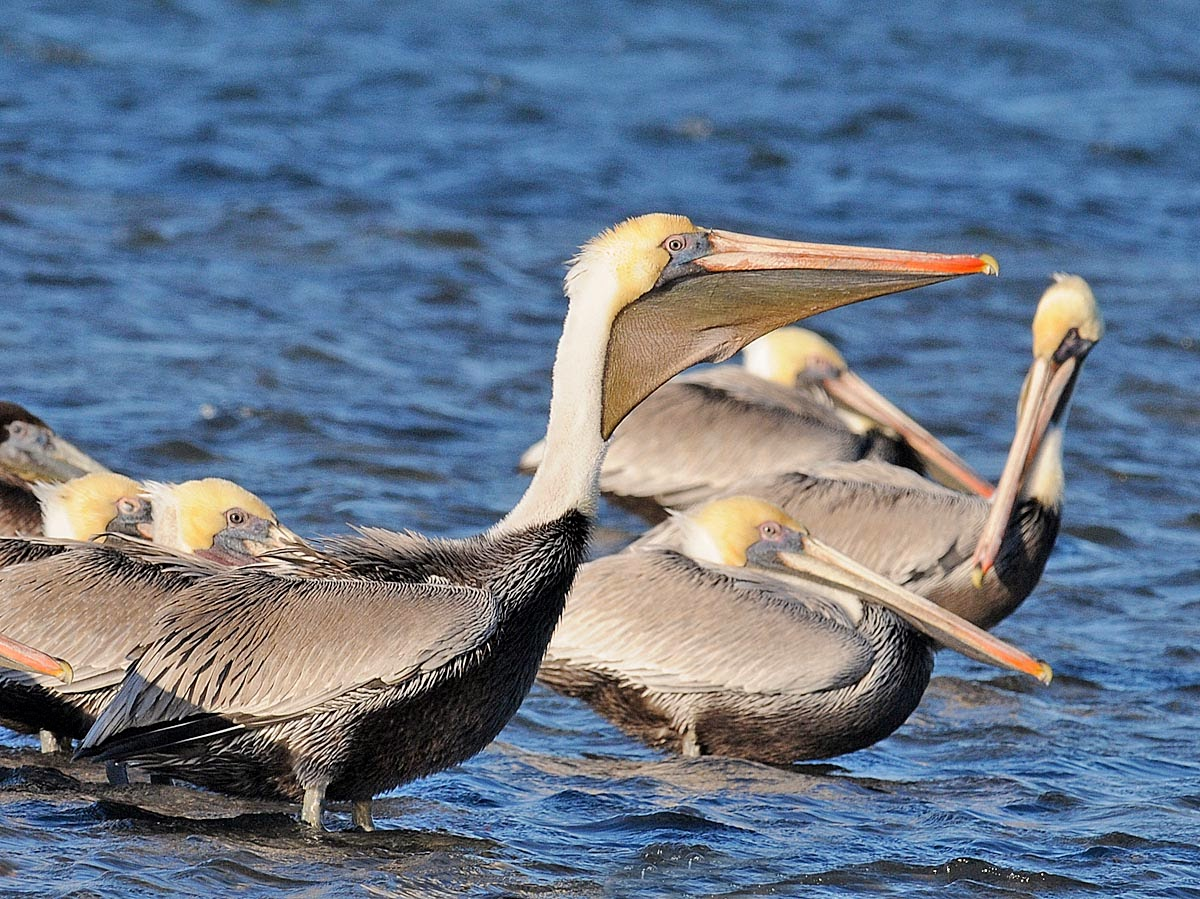"The feathered tribe are numerous, and during the season flock hither in clouds: white and black swans, white geese, Canada geese, brant, sheldrake, cormorants, loon, mallard, ducks, red-head, gray and canvas back ducks, teal, curlew, snipe, plover, pheasant, quail, pigeons, crows, and robins. During the summer months pelicans are plenty, and go sailing round in the heavy, lazy flight, occasionally dashing down into the water in the most clumsy manner to catch a fish, and at all times an easy prey and an acceptable banquet to the Indians, who swallow their coarse, fishy, oily flesh with the greatest avidity. Innumerable flocks of gulls of various species are constantly to be seen, and at times, when attracted by any quantities of food, appear like clouds. These birds, also, are readily eaten by the Indians, who never are at a loss to find means to appease their appetite."
- James Gilcrest Swan, 1852, Willapa (Shoalwater) Bay, Southwestern Washington, from his book "The Northwest Coast: Or, Three Year's in Residence in Washington Territory, 1957."
Willapa Bay A Hyper-text Notebook by Mike Garofalo
In 2022, I will be Yurt camping at Grayland Beach State Park twice and Pacific Beach State Park once during the spring bird migration fly-by. Millions of birds rest and eat in the shallow bays, wetlands, marshes, sloughs, sandy islands, and rivers in Grays Harbor Bay and Willapa Bay. Looking forward to visiting Bottle Beach and other bird watching locations.
A Birder's Guide to Coastal Washington. By Bob Morse, 2001. Featuring Ocean Shores, Long Beach Peninsula, Forks, Westport, Tokeland, and 160 Birding Hot Spots. Detailed coverage of birding locations near Westport and how to get there. Excellent resource! RWMorse, 2001, 270 pages, ring-bound. VSCL. FVRL. First Choice!!
Coastal Washington Shorebirds and Waterbirds. By Ruth McCausland. 116 pages.
Birds of Washington Field Guide. By Stan Tekiela. Adventure Pubs., 2001, 332 pages.
American Birding Association Field Guide to the Birds of Washington. By Dennis Paulson and Brian Small. Scott and Nix, 2020, 368 pages.
Birds of the Pacific Northwest. By John Shewey and Tim Blount. Timber, 2017, 560 pages.
Birds of Washington State. By Brian Bell and Gregory Kennedy. Partners, 2017, 284 pages.
"The shoals are covered with shell-fish, among which the oyster is the most abundant, and constitutes the primary article of export. Several species of clams, crabs of the largest size, and of a most delicious flavor, shrimps, mussels, and a small species of sand-lobster, are in the greatest abundance, and furnish nutritious food, not only to the different tribes of Indians who resort to the bay at different seasons to procure supplies, but also the white settler, who is this enabled to greatly reduce the expenses of living when compared with those settlements on the Columbia River and interior where provision of all kinds are usually scarce and high."
- James Gilcrest Swan, 1852, Willapa (Shoalwater) Bay, Southwestern Washington
In 2022, I will be Yurt camping at Grayland Beach State Park twice and Pacific Beach State Park once during the spring bird migration fly-by. Millions of birds rest and eat in the shallow bays, wetlands, marshes, sloughs, sandy islands, and rivers in Grays Harbor Bay and Willapa Bay. Looking forward to visiting Bottle Beach and other bird watching locations.
A Birder's Guide to Coastal Washington. By Bob Morse, 2001. Featuring Ocean Shores, Long Beach Peninsula, Forks, Westport, Tokeland, and 160 Birding Hot Spots. Detailed coverage of birding locations near Westport and how to get there. Excellent resource! RWMorse, 2001, 270 pages, ring-bound. VSCL. FVRL. First Choice!!
Coastal Washington Shorebirds and Waterbirds. By Ruth McCausland. 116 pages.
Birds of Washington Field Guide. By Stan Tekiela. Adventure Pubs., 2001, 332 pages.
American Birding Association Field Guide to the Birds of Washington. By Dennis Paulson and Brian Small. Scott and Nix, 2020, 368 pages.
Birds of the Pacific Northwest. By John Shewey and Tim Blount. Timber, 2017, 560 pages.
Birds of Washington State. By Brian Bell and Gregory Kennedy. Partners, 2017, 284 pages.
"The shoals are covered with shell-fish, among which the oyster is the most abundant, and constitutes the primary article of export. Several species of clams, crabs of the largest size, and of a most delicious flavor, shrimps, mussels, and a small species of sand-lobster, are in the greatest abundance, and furnish nutritious food, not only to the different tribes of Indians who resort to the bay at different seasons to procure supplies, but also the white settler, who is this enabled to greatly reduce the expenses of living when compared with those settlements on the Columbia River and interior where provision of all kinds are usually scarce and high."
- James Gilcrest Swan, 1852, Willapa (Shoalwater) Bay, Southwestern Washington
Fort Vancouver (1824-1845) and Portland (1845-) were the settlements inland on the Columbia River.
By 1851, epidemics of disease (1795-1845) had decimated the Chinook and Chelais Indian tribes on the Shoalwater (Willapa) Bay coastal area. In 1856, for example, a large tribe of Chelais Indians were camping in Westport and digging clams. A smallpox epidemic erupted and killed hundreds of Chelais Indians of all ages, and the Indians never returned to Westport.
By 1851, epidemics of disease (1795-1845) had decimated the Chinook and Chelais Indian tribes on the Shoalwater (Willapa) Bay coastal area. In 1856, for example, a large tribe of Chelais Indians were camping in Westport and digging clams. A smallpox epidemic erupted and killed hundreds of Chelais Indians of all ages, and the Indians never returned to Westport.
In 2022, tens of thousands of people go to dig razor clams on fixed approved days on the sandy beaches of Twin Harbors and the Long Beach Peninsula. My son and his wife are expert razor clam diggers. And, we all have been challenged by our own COVID flu pandemic in America the past three years.
Most of us enjoy finding ways and means to appease our appetites, despite any obstacles.
Travel Notebooks by Mike Garofalo


No comments:
Post a Comment